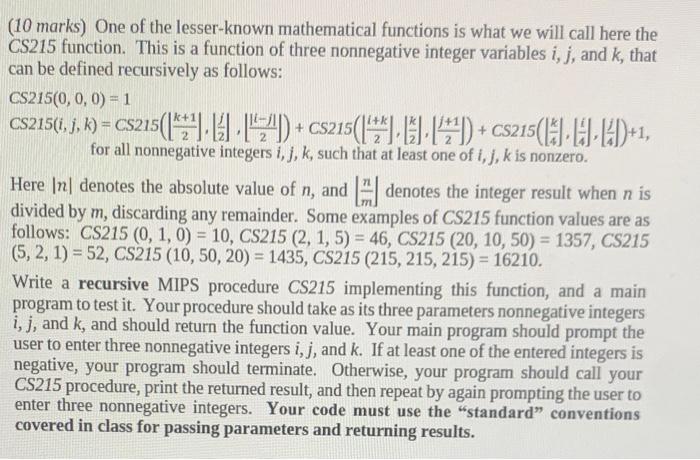Answered step by step
Verified Expert Solution
Question
1 Approved Answer
machine/assembly/qtspim (10 marks) One of the lesser-known mathematical functions is what we will call here the CS215 function. This is a function of three nonnegative
machine/assembly/qtspim 
(10 marks) One of the lesser-known mathematical functions is what we will call here the CS215 function. This is a function of three nonnegative integer variables i,j, and k, that can be defined recursively as follows: CS215(0,0,0)=1CS215(i,j,k)=CS215(2k+1,[2j,[2ij)+CS215(2i+k],[2k],[2j+1)+CS215(4k],[4i],[4j])+1, for all nonnegative integers i,j,k, such that at least one of i,j,k is nonzero. Here n denotes the absolute value of n, and mn denotes the integer result when n is divided by m, discarding any remainder. Some examples of CS215 function values are as follows: CS215(0,1,0)=10,CS215(2,1,5)=46,CS215(20,10,50)=1357,CS215 (5,2,1)=52,CS215(10,50,20)=1435,CS215(215,215,215)=16210. Write a recursive MIPS procedure CS215 implementing this function, and a main program to test it. Your procedure should take as its three parameters nonnegative integers i,j, and k, and should return the function value. Your main program should prompt the user to enter three nonnegative integers i,j, and k. If at least one of the entered integers is negative, your program should terminate. Otherwise, your program should call your CS215 procedure, print the returned result, and then repeat by again prompting the user to enter three nonnegative integers. Your code must use the "standard" conventions covered in class for passing parameters and returning results 
Step by Step Solution
There are 3 Steps involved in it
Step: 1

Get Instant Access to Expert-Tailored Solutions
See step-by-step solutions with expert insights and AI powered tools for academic success
Step: 2

Step: 3

Ace Your Homework with AI
Get the answers you need in no time with our AI-driven, step-by-step assistance
Get Started


